-
- Tracking Form Lead Source
- Show a Form Only to Logged-In Users
- How to Increment a Count on Each Form Submission
- Adding an “Other” Option
- Adding a Unique ID to Each Form Submission
- Show or Hide Form Fields Based on User Joomla User Group
- Disabling Browser Autocomplete for Form Fields
- Scroll the Page to the Top When a Long Form is Submitted
- Display Submissions Count for a Specific Form
- Populate Drop Down, Radio Buttons or Checkboxes with a CSV File
- Automatically Delete Submissions Older Than X Days
- Silently POST Submitted Data to Any API or URL
- Automatically Save Each Submission to a JSON file
- Create a Custom Login Form
- Auto-Populate Fields with Article Data
- Add a placeholder text to a Dropdown field
- Create Multilingual Forms in Joomla
- Redirect User to a URL After Form Submission
- Importing and Exporting Forms
- Exporting Form Submissions
- Display Convert Forms in a popup
-
- How to Create a Quiz Form
- Show Confirmation Popup After Submission
- Using the Conditional Content Shortcode in Convert Forms
- Copy Value From One Field to Another
- Submission Tasks
- Exporting Form Submissions with a Webhook URL
- Conditional Fields
- PDF Generator
- Input Masking
- Calculations
- Populate Fields Using Query String
- Smart Tags
-
- Minimum Time to Submit
- Restrict Form Submissions Based on IP
- Enforcing a Custom Password Policy in Convert Forms
- Add Cloudflare Turnstile to your Joomla Form
- Implement the Iubenda Consent Database in Joomla with Convert Forms
- Add Custom Validations to Fields and Forms
- Add Math Captcha to your Form
- Prevent a Field From Saving in the Database
- Add hCaptcha to your Form
- Enable Double Opt-in
- Allow Form Submissions in Specific Date Range
- Ensure a Unique Value is Entered Into a Field
- Block Form Submissions Containing Profanity (Bad Words)
- Block Email Addresses or Email Domains
- Honeypot
- Setting Up Google reCAPTCHA
- Create GDPR Compliant Forms
GetResponse Integration
Create GetResponse forms in Joomla. Integrate forms with GetResponse to grow lists, automate emails, and nurture leads.
The GetResponse addon for Convert Forms allows you to connect Joomla forms with GetResponse, enabling you to grow your email lists and automate lead nurturing. This feature lets you sync form submissions directly to your GetResponse account, triggering autoresponders and managing custom fields. Perfect for bloggers, e-commerce stores, or any business looking to automate lead generation. This guide will show you how to set it up and make the most of this integration.
Setting Up GetResponse Task
To set up the GetResponse task and sync your submissions to the GetResponse service, go into your form, and follow the steps listed below:
Select App
From within your form, click on Tasks > CREATE YOUR FIRST TASK.
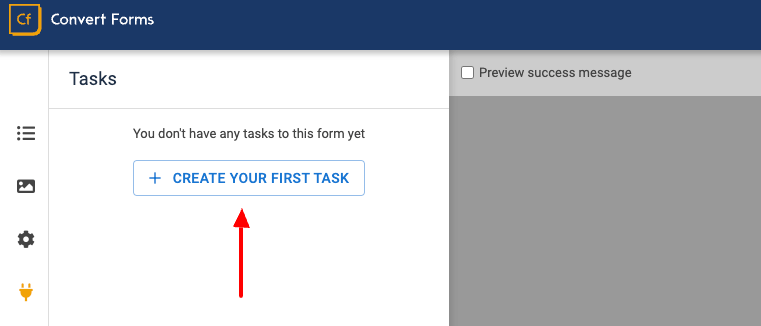
On the modal that will open, select the GetResponse task.
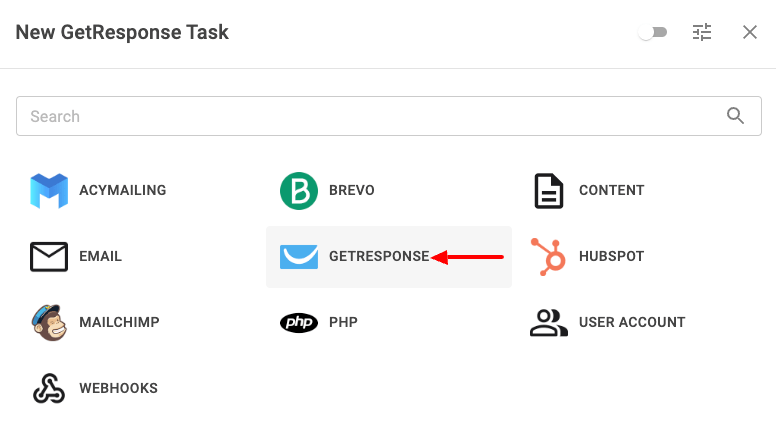
Select New Submission under Trigger and Add/Update Subscriber under Action on the next screen, and click CONTINUE.
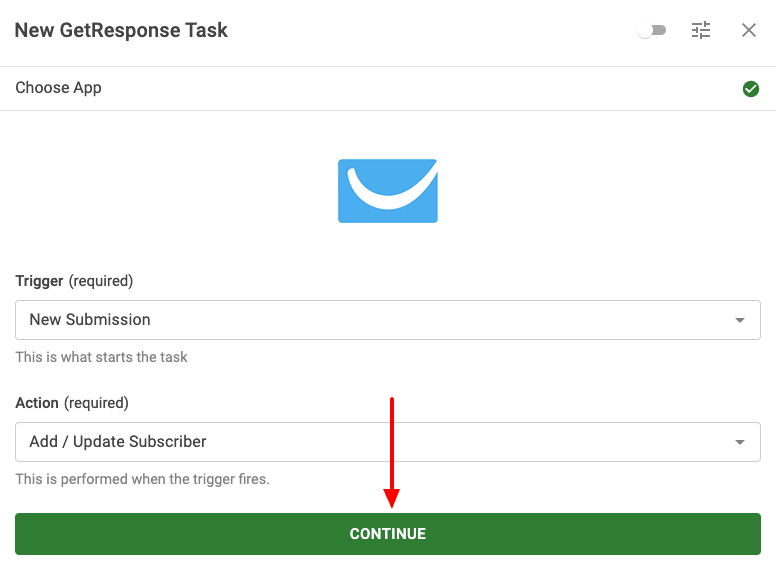
Create Connection
A connection is essential to be able to connect to a 3rd-party service, such as GetResponse. Let's see how to create a new connection that will allow us to connect to GetResponse.
On the next step, click SIGN IN to create our GetResponse connection.
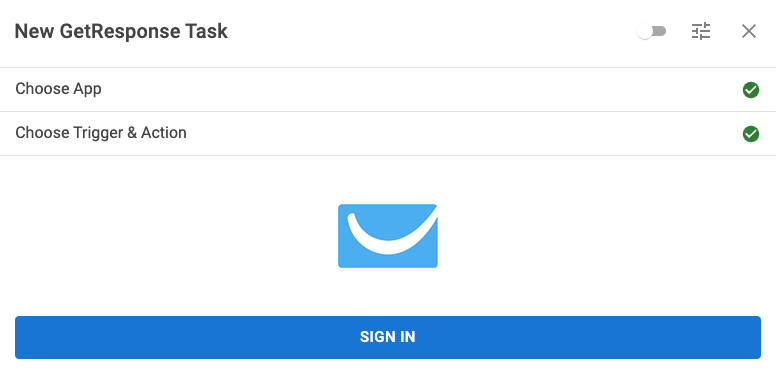
To create our connection with GetResponse, Click ADD CONNECTION to get started.

Get your GetResponse API Key
Before connecting to GetResponse, we need to create a GetResponse API Key. To grab your API Key, follow the guide (or video) here: Get my GetResponse API Key.
Now that we have created our GetResponse API Key, we can continue setting up the connection with GetResponse. Enter a connection name and paste your GetResponse API Key in the fields Connection Name and GetResponse API Key, respectively. Then click ADD CONNECTION.
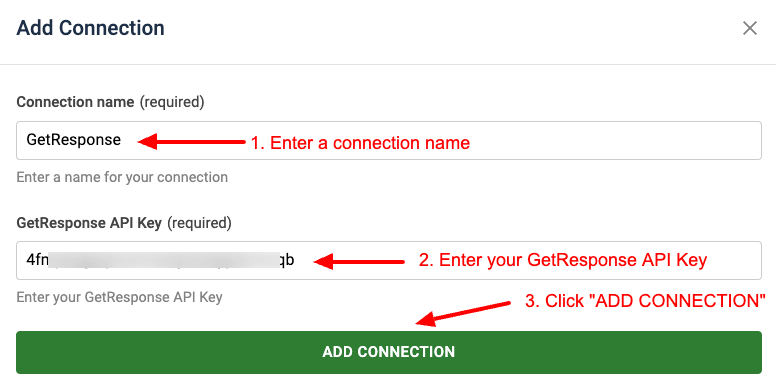
The connection has been added, and you can close the connections window.
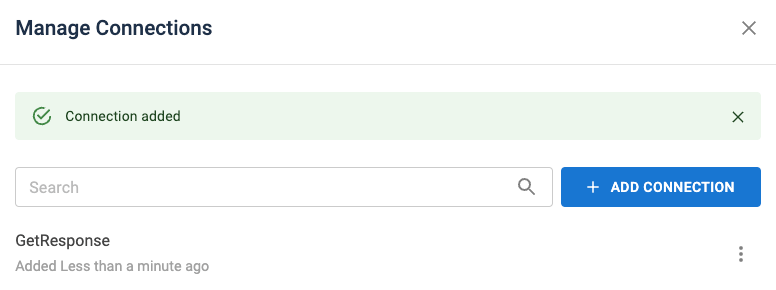
If you see the "Connection added" message, your connection with GetResponse has been established, and you can continue with the next step. If you see any error message, please review your API Key.
Select the newly created connection from the list and click CONTINUE.
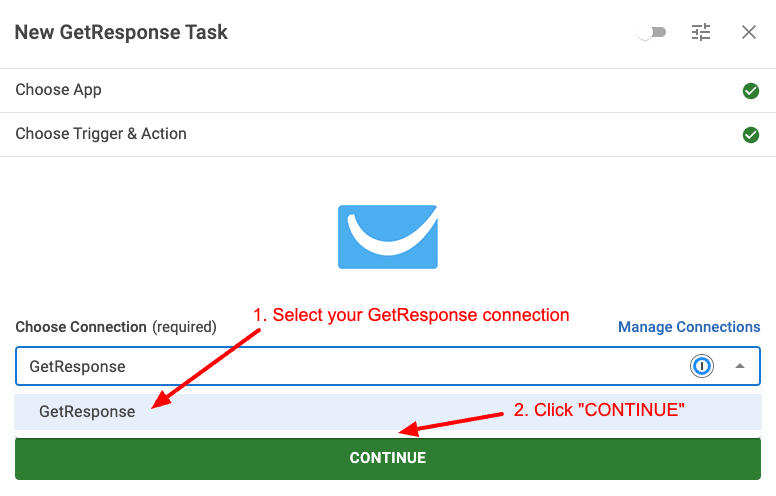
Ensure that your newly created GetResponse connection is selected in the dropdown.
Setup Action
After you've set up the trigger, action, and connection, it's time to set up the action itself and define what information to send to GetResponse. In this step, you can view all available settings and map each option with a fixed or dynamic value using Smart Tags.
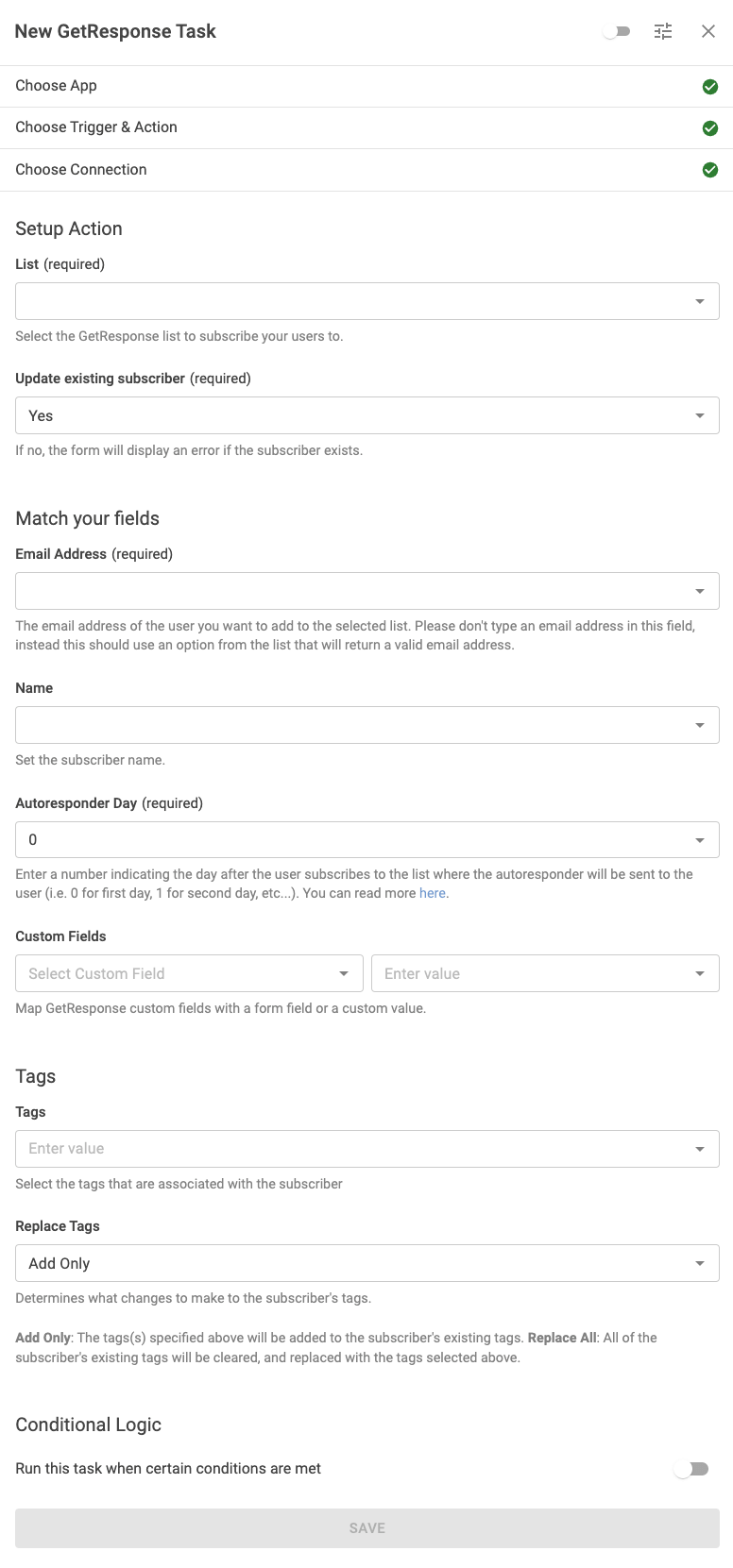
Let's see all available settings:
List
Select the list to which all subscribers will be saved in your GetResponse account. A complete list of all your GetResponse lists will be available, and choose from any form field, or Smart Tag.
Update existing subscriber
Enable to update existing subscribers' information on your GetResponse account. Disabling this will result in your users seeing an error message when the form is submitted, which prevents already subscribers from re-subscribing to your lists.
Email Address
Select the email address of the submitter. This is the user that will be subscribed to your GetResponse list. Choose the Email field in your form.
Name
Set the name of the subscriber.
Autoresponder Day
Custom Fields
GetResponse provides Custom Fields, which allows you to store additional information when a subscriber is saved on your GetResponse account, such as their name, age, company info, and more!
When you click on the Custom Fields dropdown, you will automatically be shown a list of existing custom fields from your GetResponse account, and you will be able to map them with an existing form field, or Smart Tag.
To create or edit your GetResponse custom fields please click here: How to create and use GetResponse custom fields.
That's it! Your custom field can now be used in your GetResponse task.
Add Conditional Logic
Conditional logic makes it possible to run tasks only if specific criteria are met, like a user’s email address matching a certain domain, the user being associated with a certain Joomla User Group, or a form submission having a specific value.
While editing the GetResponse task, go to the Setup Action step and scroll down to the Conditional Logic section to set up Conditional Logic. Here's where you define all the rules the task should meet to run.
For example, let's say we need to sync submissions to GetResponse, only if the email is coming from a specific domain: @domain.com.
- Click to enable the Run this task when certain conditions are met.
- Click Add Your First Condition.
- Select the Email field in the Trigger dropdown.
- Select Contains in the Operator dropdown.
- Enter @domain.com in the value. Replace this with your domain name.
The condition should look like this:
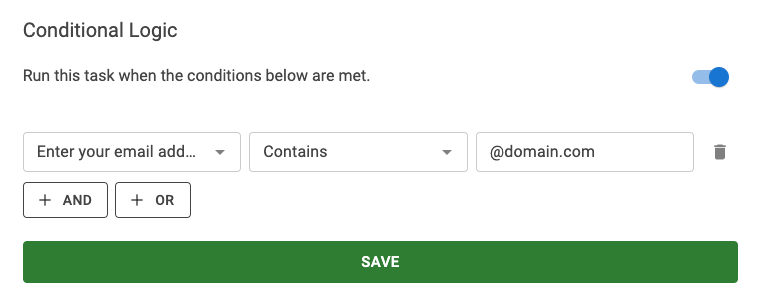
You can read more on Conditional Logic on the Working with Tasks documentation page.
Activate Task
The final step is to enable our task. To do so, click the toggle on the dialog’s top right corner, as shown in the screenshot below.

Finally, click Save to save the task, close the dialog, and then click Save from the top right corner of the form builder to save the changes on the form.
Congratulations! You’ve successfully created a form that syncs new submissions to GetResponse!
Frequently Asked Questions
What are Autoresponders and Autoresponder Day?
Autoresponders are messages set to go out automatically after a contact subscribes to your list.
The Autoresponder Day is a number that starts from 0 indicating day 0 (the day a contact subscribes). You can use any day after the user subscribers to your list such as day 3, 7, 14, etc... So, autoresponders are useful if you want to send an automatic message to contacts who join your list. When you set up an autoresponder cycle, messages will go out on a specific day of a contact’s subscription period, according to how you set up the cycle.
You can read more below:







 Rated:
Rated: 